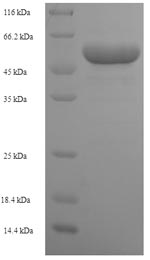This Human PRPS1 recombinant protein was produced in E.coli, where the gene sequence encoding Human PRPS1 (2-318aa) was expressed with the N-terminal 6xHis-SUMO tag. The purity of this PRPS1 protein was greater than 90% by SDS-PAGE.
PRPS1 is a key enzyme in the biosynthesis of ribonucleotides (components of RNA and DNA). PRPP is the precursor required for the synthesis of nucleotides, which play various crucial biological roles in cells, including genetic information transfer and protein synthesis.
Mutations in the PRPS1 gene can lead to a genetic disorder known as PRPS superactivity syndrome (PRPS overactivity syndrome or PRS superactivity syndrome). This is a group of rare disorders characterized by multisystem symptoms, including neurological issues, abnormal purine metabolism, and intellectual developmental delay. The occurrence of these symptoms is associated with abnormal activity of the PRPS1 enzyme due to mutations in the PRPS1 gene.
As PRPS1 is a critical enzyme in the biosynthesis of ribonucleotides, it is considered a potential target for anticancer drugs. Some drugs aim to inhibit cancer cell growth and proliferation by disrupting the function of PRPS1, thereby interfering with nucleotide synthesis in these cells.






